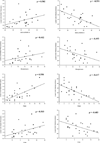Movement orientation switching with the eyes and lower limb in Parkinson disease
- PMID: 22261609
- PMCID: PMC3354036
- DOI: 10.1016/j.parkreldis.2012.01.002
Movement orientation switching with the eyes and lower limb in Parkinson disease
Abstract
Difficulty switching between motor programs is a proposed cause of motor blocks in Parkinson disease (PD). Switching from one movement to another has been studied in the upper extremity and during postural control tasks, but not yet in the eyes and lower limb in PD. The purpose of this study was to compare movement orientation switching ability between people with PD and age-matched controls (CON) and to determine if switching ability is correlated between the eyes and lower limb. Twenty-six persons with PD and 19 age-matched controls participated. Movement orientation switching was studied in a seated position with the head fixed in a chinrest. In response to a randomly generated tone, participants switched from a continuous back-and-forth movement in either the horizontal or vertical orientation to the opposite orientation as quickly as possible. Lower limb movements were performed with the great toe pointing back and forth between targets positioned on a 45° angled floor platform. Eye movements were back and forth between the same targets. Eye and lower limb switch time was reduced in PD (p<0.01), but after normalizing switch time to movement velocity, no differences existed between PD and CON. Eye and lower limb switch times were correlated in PD (r=0.513, p<0.01) but not in CON. In PD, switch time and movement velocity of the lower limb, but not the eyes, correlated with bradykinesia and postural instability/gait. Our results suggest that individuals with PD experience movement-switching deficits with both the eyes and lower limb, perhaps driven by overall bradykinesia.
Copyright © 2012 Elsevier Ltd. All rights reserved.
Figures



References
-
- Mink JW. The basal ganglia: focused selection and inhibition of competing motor programs. Prog Neurobiol. 1996;50:381–425. - PubMed
-
- Marsden CD. Motor disorders in basal ganglia disease. Hum Neurobiol. 1984;2:245–250. - PubMed
-
- Stelmach GE, Worringham CJ, Strand EA. The programming and execution of movement sequences in Parkinson's disease. Int J Neurosci. 1987;36:55–65. - PubMed
-
- Inzelberg R, Plotnik M, Flash T, Schechtman E, Shahar I, Korczyn AD. Mental and motor switching in Parkinson's disease. J Mot Behav. 2001;33:377–385. - PubMed
-
- Giladi N, McMahon D, Przedborski S, Flaster E, Guillory S, Kostic V, et al. Motor blocks Parkinson's disease. Neurology. 1992;42:333–339. - PubMed
Publication types
MeSH terms
Grants and funding
LinkOut - more resources
Full Text Sources
Medical

